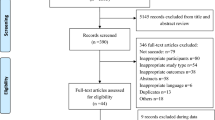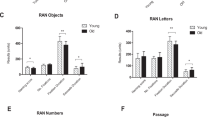Abstract
While a delayed initiation of visually guided saccades with increasing age has been documented in a number of studies, little research has been done on the control of antisaccades. The present study investigates aging effects on the control of visually guided saccades (prosaccades) and antisaccades as well as a selection of neuropsychological functions by the cross-sectional comparison of 14, 22, and 16 participants aged 20–35 years, 59–73 years, and 74–88 years, respectively. The geriatric and neurological status of the elder participants (including evidence from computed tomography, electroencephalography, and neurological soft signs) was assessed. In four task blocks of 200 trials each, pro- and antisaccades were elicited under the 200-ms-gap and overlap conditions. Left- and right-sided stimuli were presented in random order at 4°, and the order of the task blocks was varied within each age group. In addition, the Wisconsin card-sorting test (WCST) and working memory, go-nogo discrimination, alertness, and stimulus-response incompatibility tests were administered. Participants aged 59–73 years exhibited widespread reductions of optomotor and neuropsychological performance, with greatest effect sizes of age differences in the optomotor parameters and the WCST measures. A further decay after the age of 73 years was discernible in those optomotor functions reflecting saccade disinhibition (in particular, directional errors during the antisaccade task and premature responses) and the performance in some neuropsychological tests. In line with previously published reports, variance in optomotor performance could be explained by two factors, accounting for a total of 76% of the age variance. Our results suggest that the investigation of saccade control may be a highly sensitive tool for neurodevelopmental aging research.
Similar content being viewed by others
References
Abel LA, Troost BT, Dell’Osso LF (1983) The effects of age on normal saccadic characteristics and their variability. Vision Res 23:33–37
Albeit M, Stafford JL (1986) CT scan and neuropsychological relationships in aging and dementia. In: Goldstein G, Tasker RE (eds) Advances in clinical neuropsychology (vol 3). Plenum, New York, pp 31–53
Arbuckle TY, Gold DP (1993) Aging, inhibition and verbosity. J Gerontol Psychol Sci 48:225–232
Carter JC, Obler L, Woodward S, Albert,ML (1983) The effect of increasing age on the latency for saccadic eye movements. J Gerontol 38:318–320
Chu FC, Reingold DB, Cogan DG, Williams AC (1979) The eye movement disorders of progressive supranuclear palsy. Ophthalmology 86:422–428
Coffey CE, Wilkinson WE, Parashos IA, et al. (1992) Quantitative cerebral anatomy of the aging human brain: a cross-sectional study using magnetic resonance imaging. Neurology 42:527–535
Cohen J (1988) Statistical power analysis for the behavioral sciences (2nd edn) Lawrence Erlbaum Associates, Hillsdale, NJ
DeLeon MJ, George AE, Tomanelli J, Christman D, Kluger A, et al. (1987) Positron emission tomography studies of normal aging: a replication of PET III and 18-FDG using PET VI and 11-CDG. Neurobiol Aging 8:319–323
Décary A, Richer R (1995) Response selection deficits in frontal excisions. Neuropsychologia 33:1243–1253
Dorris CM, Munoz DP (1995) A neural correlate for the gap effect on saccadic reaction times in monkey. J Neurophysiol 73:2558–2562
Drewe EA (1975) Go-no go learning after frontal lobe lesions in humans. Cortex 11:8–16
Dustman RE, Emmerson RY, Shearer DE (1996) Life span changes in electrophysiological measures of inhibition. Brain Cogn 30:109–126
Evdokimidis I, Liakopoulos D, Constantinidis TS, Papageorgiou C (1996) Cortical potentials with antisaccades. Electroencepha-logr Clin Neurophysiol 98:377–384
Everling S, Krappmann P, Flohr H (1997) Cortical potentials preceding pro- and antisaccades in man. Electroencephalogr Clin Neurophysiol 102:356–362
Everling S, Fischer B (1998) The antisaccade: a review of basic research and clinical studies. Neuropsychologia 36:885–899
Fabiani M, Friedman D (1996) Dissociations between memory for temporal order and recognition memory in aging. Neuropsychologia 35:129–141
Fischer B, Weber H (1997) Effects of stimulus conditions on the performance of antisaccades in Man. Exp Brain Res 116:191–200
Fischer B, Biscaldi M, Gezeck S (1997a) On the development of voluntary and reflexive components in human saccade generation. Brain Res 754:285–297
Fischer B, Gezeck S, Hartnegg K (1997b) The analysis of saccadic eye movements from gap and overlap paradigms. Brain Res Protoc 2:47–52
Fukushima J, Fukushima K, Chiba T, Tanaka S, Yamashita I, Kato M (1988) Disturbances of voluntary control of saccadic eye movements in schizophrenic patients. Biol Psychiatry 23:670–677
Fukushima J, Fukushima K, Morita N, Yamashita I (1990) Further analysis of the control of voluntary saccadic eye movements in schizophrenic patients. Biol Psychiatry 28:943–958
Fuster JM (1989) The prefrontal cortex: anatomy, physiology and neuropsychology of the frontal lobe, 2nd edn. Raven, New York
Goldberg ME, Bushnell MC, Bruce CJ (1986) The effects of attentive fixation on eye movements evoked by electrical stimulation of the frontal eye fields. Exp Brain Res 61:579–584
Gooding DC (1999) Antisaccade task performance in questionnaire-identified schizotypes. Schizophr Res 35:157–166
Guitton D, Buchtel HA, Douglas RM (1985) Frontal lobe lesions in Man cause difficulties in suppressing reflexive glances and in generating goal-directed saccades. Exp Brain Res 58:455–472
Gur RC, Gur RE, Obrist WD, Skolnick BE, Reivitch M (1987) Age and regional cerebral blood flow at rest and during cognitive activity. Arch Gen Psychiatry 44:617–621
Hallett PE (1978) Primary and secondary saccades to goals defined by instructions. Vision Res 18:1279–1296
Haug H, Barmwater U, Eggers R, Fischer D, Kuhl S, Sass NL (1983) Anatomical changes in the aging brain: morphometric analysis of the human prosencephalon. In: Cerbos-Navarro J, Sarkander HI (eds) Neuropharmacology, vol 21. Raven, New York, pp 1–12
Heller KA, Kratzmeier H, Lengfelder A (1998) Standard progressive matrices/Matrizen-test-manual (Band 1) Beltz Test
Henriksson NG, Pyykkoe Schalen L, Wennmo C (1980) Velocity patterns of rapid eye movements. Acta Otolaryngol (Stockh) 89:504–512
Hotson JR, Steinke GW (1988) Vertical and horizontal saccades in aging and dementia. Neuro-ophthalmol 8:267–273
Huaman AG, Sharpe JA (1993) Vertical saccades in senescence. Invest Ophthalmol Vis Sci 34:2588–2595
Iacono WG, Tuason VB, Johnson RA (1981) Dissociation of smooth-pursuit and saccadic eye tracking in remitted schizophrenics. Arch Gen Psychiatry 38:991–996
Jernigan TL, Archibald SL, Berhow MT, Sowell ER, Foster DS, Hesselink JR (1991) Cerebral structure on MRI. I. Localization of age-related changes. Biol Psychiatry 29:55–67
Karoumi B, Ventre-Dominey J, Vighetto A, Dalery J, d, T (1998) Saccadic eye movements in schizophrenic patients. Psychiatry Res 77:9–21
Katsanis J, Iacono WG, Harris, M (1998) Development of oculomotor functioning in preadolescence, adolescence, and adulthood. Psychophysiology 35:64–72
Klein C, Foerster F (2000) Development of pro- and antisaccade performance in participants aged 6 to 26 years. Psychophysiology (in press)
Klein C, Heinks T, Andersen B, Berg P, Moritz S (2000) Impaired modulation of the saccadic CNV preceding anti-saccades in schizophrenia. Biol Psychiatry 47:978–990
Kramer AF, Humphrey DG, Larish JF, Logan GD, Strayer DL (1994) Aging and inhibition: beyond a unitary view of inhibitory processing in attention. Psychol Aging 9:491–512
Martin A, Friston KJ, Colebatch JG, Frackowiak RS (1991) Decreases in regional cerebral blood flow with normal aging. J Cereb Blood Flow Metab 11:684–689
McDowell, JE, Clementz BA (1997) The effect of fixation condition manipulations on antisaccade performance in schizophrenia: studies of diagnostic specificity. Exp Brain Res 115:333–344
Mega MS, Cummings JL (1994) Frontal-subcortical circuits in neuropsychiatrie disorders. J Neuropsychiatry Clin Neurosci 6:358–370
Milner B (1963) Effects of different brain lesions on card sorting. Arch Neurol 9:90–100
Moschner C, Baloh RW (1994) Age-related changes in visual tracking. J Gerontol 49:235–238
Munoz DP, Wurtz RH (1995) Saccade-related activity in monkey superior colliculus. I. Characteristics of burst and buildup cells. J Neurophysiol 73:2313–2333
Nkam I, Thibaut F, Denise P, Levillain D, Segard L, Langlois-Thery S (1998) Saccadic eye movements and Wisconsin card sorting test in deficit and nondeficit schizophrenia. Schizophr Res 29:117 (Abstract)
O’Driscoll GA, Alpert NM, Matthysse SW, Levy DL, Rauch SL, Holzman PS (1995) Functional neuroanatomy of antisaccade eye movements investigated with positron emission tomography. Proc Nat Acad Sci USA 92:925–929
Olincy A, Ross RG, Young DA, Freedman R (1997) Age diminishes performance on an antisaccade eye movement task. Neurobiol Aging 18:483–489
Pardo JV, Fox PT, Raichle ME (1991) Localization of a human system for sustained attention by positron emission tomography. Nature 349:61–64
Pierrot-Deseilligny C, Rivaud S, Gaymard B, Agid Y (1991a) Cortical control of reflexive visually guided saccades. Brain 114:1473–1485
Pierrot-Deseilligny C, Rivaud S, Gaymard B, Agid Y (1991b) Cortical control of memory-guided saccades in Man. Exp Brain Res 83:607–617
Pierrot-Deseilligny C, Rivaud S, Gaymard B, Muri RM, Vermersch AI (1995) Cortical control of saccades. Ann Neurol 3:557–567
Pirozzolo FJ, Hansch EC (1981) Oculomotor reaction time in dementia reflects degree of cerebral dysfunction. Science 214:349–351
Pitt MC, Rawles JM (1988) The effect of age on saccade latency and velocity. Neuro-ophthalmology 8:123–129
Rafal R, Gershberg F, Egly R, Ivry R, Kongstone A, Ro T (1996) Response channel activation and the lateral prefrontal cortex. Neuropsychologia 34:1197–1202
Reuter-Lorenz PA, Hughes HC, Fendrich R (1991) The reduction of saccadic latency by prior offset of the fixation point: an analysis of the gap effect. Percept Psychophys 49:167–175
Reuter-Lorenz PA, Oonk HM, Barnes LL, Hughes HC (1995) Effects of warning signals and fixation point offsets on the latencies of pro- versus antisaccades: implications for an interpretation of the gap effect. Exp Brain Res 103:287–293
Rivaud S, Muri RM, Gaymard B, Vermersch AI, Pierrot-Deseilligny C (1994) Eye movement disorders after frontal eye field lesions in humans. Exp Brain Res 102:110–120
Rosenhall U, Bjoerkman G, Pedersen K, Hanner P (1987) Oculomotor tests in different age groups. In: Graham MD, Kemink JK (eds) The vestibular system: neurophysiologic and clinical research. Raven, New York, pp 401–409
Rosse RB, Schwartz BL, Kim SY, Deutsch SI (1993) Correlation between antisaccade and Wisconsin card sorting test performance in schizophrenia. Am J Psychiatry 150:333–335
Saslow MG (1967) Effects of components of displacement step stimuli upon latency for saccadic eye movements. J Opt Soc Am 57:1024–1029
Schlenker R, Cohen R (1995) Smooth pursuit eye-movement dysfunction and motor control: a follow-up study. Eur Arch Psychiatry Clin Neurosci 245:125–126
Sereno AB, Holzman PS (1995) Antisaccades and smooth pursuit eye movements in schizophrenia. Biol Psychiatry 37:394–401
Sharpe JA, Zackon DH (1987) Senescent saccades. Effects of aging on their accuracy, latency, and velocity. Acta Otolaryngol (Stockh) 104:422–428
Spooner JW, Sakala SM, Baloh, RW (1980) Effect of aging on eye tracking. Arch Neurol 37:575–576
Stevens J (1986) Applied multivariate statistics for the social sciences. Lawrence Erlbaum, Hillsdale NJ
Tedeschi G, DiCostanzo A, Alloca S, et al. (1989) Age-dependent changes in visually guided saccadic eye movements. Functional Neurol 4:363–367
Walker R, Husain M, Hodgson TL, Harrison J, Kennard C (1998) Saccadic eye movements and working memory deficits following damage to human prefrontal cortex. Neuropsychologia 36:1141–1159
Warabi T, Kase M, Kato T (1984) Effect of aging on visually guided saccadic eye movements. Ann Neurol 16:449–454
Wennmo C, Emgard P, Henriksson NG, Scholtz HJ (1984) Vertical saccades in brainstem disorders. Acta Otolaryngol (Stockh) 406:239–241
West RL (1996) An application of prefrontal cortex function theory to cognitive aging. Psychol Bull 120:272–292
Zimmermann P, Fimm B (1993) Testbatterie zur Aufmerk-samkeitsprüfung (TAP) Version 1.0: Handbuch. Psytest
Author information
Authors and Affiliations
Corresponding author
Additional information
Published online: 2 September 2000
Research was supported by the University of Freiburg and the Deutsche Forschungsgemeinschaft (Kl 985/4-1).
Rights and permissions
About this article
Cite this article
Klein, C., Fischer, B., Hartnegg, K. et al. Optomotor and neuropsychological performance in old age. Exp Brain Res 135, 141–154 (2000). https://doi.org/10.1007/s002210000506
Received:
Accepted:
Issue Date:
DOI: https://doi.org/10.1007/s002210000506




